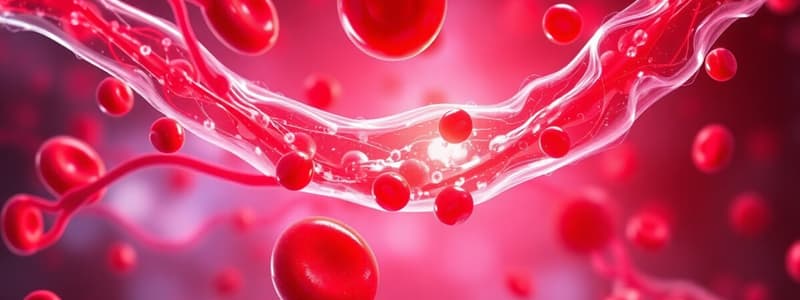Podcast
Questions and Answers
Which statement accurately contrasts thrombus and embolus formation?
Which statement accurately contrasts thrombus and embolus formation?
- An embolus is stationary, while a thrombus refers to the movement of that clot within blood vessels.
- A thrombus is stationary, while an embolus dissolves blood clots.
- A thrombus refers to a blood clot, while an embolus is the movement of that clot within blood vessels. (correct)
- An embolus refers to the physiological clotting of blood, while a thrombus moves throughout blood vessels.
What is the primary mechanism by which the coagulation system amplifies its response during clot formation?
What is the primary mechanism by which the coagulation system amplifies its response during clot formation?
- Inhibition of fibrin production.
- Reduction in the production of Vitamin K-dependent clotting factors.
- Each activated factor serving as a catalyst for the next reaction. (correct)
- Direct activation of plasminogen.
What role does plasmin play in the fibrinolytic system?
What role does plasmin play in the fibrinolytic system?
- Plasmin directly inhibits the activation of plasminogen, preventing excessive clot breakdown.
- Plasmin breaks down the fibrin thrombus into degradation products, limiting embolus formation. (correct)
- Plasmin initiates the synthesis of fibrin within the clot, stabilizing its structure.
- Plasminogen assists in converting plasmin into fibrin.
How do hemorheological drugs differ from antiplatelet drugs in modifying platelet function?
How do hemorheological drugs differ from antiplatelet drugs in modifying platelet function?
Which statement accurately describes the effect of anticoagulants on existing blood clots?
Which statement accurately describes the effect of anticoagulants on existing blood clots?
Why is unfractionated heparin monitored with frequent laboratory tests, unlike low-molecular-weight heparins?
Why is unfractionated heparin monitored with frequent laboratory tests, unlike low-molecular-weight heparins?
What explains the delayed onset and prolonged duration of action of warfarin?
What explains the delayed onset and prolonged duration of action of warfarin?
What is the primary reason coagulation monitoring is not required for patients taking dabigatran?
What is the primary reason coagulation monitoring is not required for patients taking dabigatran?
What is the primary mechanism behind the increased risk of bleeding associated with anticoagulant use?
What is the primary mechanism behind the increased risk of bleeding associated with anticoagulant use?
How does heparin-induced thrombocytopenia (HIT) type II differ from type I in terms of platelet response and treatment?
How does heparin-induced thrombocytopenia (HIT) type II differ from type I in terms of platelet response and treatment?
What is the critical rationale for administering intravenous protamine sulfate in cases of heparin toxicity?
What is the critical rationale for administering intravenous protamine sulfate in cases of heparin toxicity?
What is the underlying mechanism by which high doses of intravenous vitamin K counteract the effects of warfarin?
What is the underlying mechanism by which high doses of intravenous vitamin K counteract the effects of warfarin?
How does enzyme inhibition of metabolism contribute to drug interactions among anticoagulants?
How does enzyme inhibition of metabolism contribute to drug interactions among anticoagulants?
Which nursing measure is most crucial when administering heparin intravenously for a therapeutic effect?
Which nursing measure is most crucial when administering heparin intravenously for a therapeutic effect?
How would you describe the relationship between hemostasis and coagulation?
How would you describe the relationship between hemostasis and coagulation?
How would you best describe the role of fibrinolysis in the maintenance of hemostasis?
How would you best describe the role of fibrinolysis in the maintenance of hemostasis?
In the context of the coagulation cascade, what implies 'amplification' of the next reaction?
In the context of the coagulation cascade, what implies 'amplification' of the next reaction?
In what way does the administration of antifibrinolytic drugs impact the body's hemostatic balance?
In what way does the administration of antifibrinolytic drugs impact the body's hemostatic balance?
Which is a critical distinction between unfractionated heparin (UFH) and low-molecular-weight heparin (LMWH)?
Which is a critical distinction between unfractionated heparin (UFH) and low-molecular-weight heparin (LMWH)?
What distinguishes the mechanism of action of direct thrombin inhibitors like dabigatran from that of heparin?
What distinguishes the mechanism of action of direct thrombin inhibitors like dabigatran from that of heparin?
What is the primary rationale for using heparin flushes (10-100 units/mL) for catheter maintenance?
What is the primary rationale for using heparin flushes (10-100 units/mL) for catheter maintenance?
In a patient receiving warfarin, how does genetic variability in CYP2C9 and VKORC1 influence the drug's anticoagulant effect?
In a patient receiving warfarin, how does genetic variability in CYP2C9 and VKORC1 influence the drug's anticoagulant effect?
How does the mechanism of thrombolytic drugs such as alteplase differ from that of anticoagulants such as heparin?
How does the mechanism of thrombolytic drugs such as alteplase differ from that of anticoagulants such as heparin?
Which key factor differentiates Type I heparin-induced thrombocytopenia (HIT) from Type II HIT?
Which key factor differentiates Type I heparin-induced thrombocytopenia (HIT) from Type II HIT?
What is the fundamental reason for the higher incidence of heparin-induced thrombocytopenia (HIT) with bovine heparin?
What is the fundamental reason for the higher incidence of heparin-induced thrombocytopenia (HIT) with bovine heparin?
Why is protamine sulfate administered intravenously to counteract the toxic effects of heparin?
Why is protamine sulfate administered intravenously to counteract the toxic effects of heparin?
What is the primary mechanism by which high doses of intravenous vitamin K reverse the effects of warfarin?
What is the primary mechanism by which high doses of intravenous vitamin K reverse the effects of warfarin?
How might enzyme inhibition of metabolism in drug interactions affect the anticoagulant effects of warfarin?
How might enzyme inhibition of metabolism in drug interactions affect the anticoagulant effects of warfarin?
Why is it important to administer subcutaneous heparin in areas of deep subcutaneous fat and to rotate injection sites?
Why is it important to administer subcutaneous heparin in areas of deep subcutaneous fat and to rotate injection sites?
Which patient education point is most important for a patient starting on warfarin?
Which patient education point is most important for a patient starting on warfarin?
A patient on warfarin is also prescribed an herbal supplement. What is the most critical instruction to provide?
A patient on warfarin is also prescribed an herbal supplement. What is the most critical instruction to provide?
What is a critical sign of internal bleeding to monitor for in a patient receiving thrombolytic drugs?
What is a critical sign of internal bleeding to monitor for in a patient receiving thrombolytic drugs?
Which statement accurately describes the action of antiplatelet drugs?
Which statement accurately describes the action of antiplatelet drugs?
Aspirin is contraindicated in children and adolescents with flu-like symptoms due to the risk of what condition?
Aspirin is contraindicated in children and adolescents with flu-like symptoms due to the risk of what condition?
Flashcards
Hemostasis
Hemostasis
General term for any process that stops bleeding.
Thrombus
Thrombus
A blood clot; stationary.
Embolus
Embolus
A thrombus that moves through blood vessels.
Fibrinolytic System
Fibrinolytic System
Signup and view all the flashcards
Fibrinolysis
Fibrinolysis
Signup and view all the flashcards
Anticoagulants
Anticoagulants
Signup and view all the flashcards
Antiplatelet drugs
Antiplatelet drugs
Signup and view all the flashcards
Thrombolytic drugs
Thrombolytic drugs
Signup and view all the flashcards
Antifibrinolytic/hemostatic
Antifibrinolytic/hemostatic
Signup and view all the flashcards
Warfarin (Coumadin)
Warfarin (Coumadin)
Signup and view all the flashcards
Bleeding (Anticoagulant)
Bleeding (Anticoagulant)
Signup and view all the flashcards
Protamine sulfate
Protamine sulfate
Signup and view all the flashcards
Treatment: Toxic Effects of Warfarin
Treatment: Toxic Effects of Warfarin
Signup and view all the flashcards
Study Notes
- Coagulation Modifier Drugs alter the body's ability to form blood clots
- Hemostasis is any process that stops bleeding
- Coagulation is hemostasis from blood's physiological clotting
- Thrombus is technical term for a blood clot
- Embolus is a thrombus that moves
Coagulation System
- It occurs from a cascade of reactions
- Each activated factor acts as a catalyst to amplify the next reaction
- The result is fibrin, a clot-forming substance
- Involves both intrinsic and extrinsic pathways
Fibrinolytic System
- It initiates the breakdown of clots, balancing the clotting process
- Fibrinolysis is the mechanism that lyses formed thrombi, preventing excessive clot formation and blockage
- Fibrin binds to plasminogen; converting it to plasmin
- Plasmin is an enzyme that breaks down the fibrin thrombus into degradation products
- Plasmin keeps the thrombus localized, preventing embolus formation
Coagulation Modifier Drugs
- Anticoagulants inhibit clotting factor action or formation, thus preventing clot formation
- Antiplatelet drugs inhibits platelet aggregation, preventing plugs
- Hemorheological drugs alter platelet function without fully stopping platelet work
- Thrombolytic drugs lyse existing clots
- Antifibrinolytic or hemostatic drugs promote blood coagulation
Anticoagulants
- It is also known as antithrombotic drugs
- These drugs have no direct effect on already formed clots
- Anticoagulants prevent intravascular thrombosis by reducing blood coagulability
- Used to prevent clot formation or thrombus and embolus formation
- Heparins are a type of anticoagulant
- It inhibits factors IIa (thrombin), Xa, and IX
- Factors XI and XII are also impacted
- Unfractionated heparin is commonly referred to as "heparin"
- Low-molecular-weight heparins include enoxaparin (Lovenox), dalteparin (Fragmin), nadroparin calcium (Fraxiparine), and tinzaparin sodium (Innohep).
- Unfractionated heparin is derived from animal sources
- Frequent lab monitoring is important with aPTT with unfractionated heparin
- No monitoring is needed with heparin for catheter flush at 10-100 units/MmL
- LMWHs like enoxaparin are synthetic with a smaller molecular structure
- It has a predictable anticoagulant response, with no lab testing
Warfarin
- Warfarin (Coumadin) inhibits vitamin K synthesis
- It inhibits vitamin K-dependent clotting factors II, VII, IX, and X, made normally in liver
- The final preventative effect, is the prevention of clot formation
- Action begins 24-72 hr, with a peak in 4 hours
- The elimination half-life is 0.5-3 days, and the duration of action is 2-5 days
Antithrombin Medications
- They inhibit thrombin and factor IIa
- Natural antithrombin medication is human antithrombin III (Thrombate)
- Synthetic antithrombin medications include lepirudin (Refludan), argatroban (Argatroban), bivalirudin (Angiomax), and dabigatran (Pradaxa)
- Direct acting Xa inhibitors include fondaparinux (Arixtra), rivaroxaban (Xarelto), and apixaban (Eliquis)
- Direct thrombin inhibitor is dabigatran
- Dabigatran etexilate mesylate (Pradaxa) is the first oral direct thrombin inhibitor
- It is approved to prevent strokes and thrombosis in nonvalvular conditions
- It is activated by the liver and binds to free and clot-bound thrombin
- Excreted by the kidneys, the dose depends on kidney function
- The standard dose is 150 mg BID, and must be reduced to 75 mg BID with renal impairment (less than 30 mL creatine clearance)
- Bleeding is its most serious adverse event
- Coagulation monitoring not required
- The onset of action is 2-3 hours PO, reaching peak in 2 hours
- Elimination is 12-17 hours, with 12 hours duration of action
- Anticoagulants act at different areas of the clotting cascade
- It does not lyse existing clots
Anticoagulant Indications
- Used to prevent clot formation, for settings:
- Myocardial infarction
- Unstable angina
- Artial fibrillation
- Indwelling devices like mech heart valves
- Conditions that slow blood flow like major orthopedic surgery and prolonged immobility
Anticoagulant Contraindications & Adverse Effects
- Drug allergies
- Any acute bleeding
- Warfarin is contraindicated in pregnancy, and other anticoagulants have lower categories
- LMWH is also contraindicated in patients with an indwelling epidural catheter, due to the risk of an epidural hematoma
- Bleeding has increased risk with increased dosages, and maybe systemic
- Cause Heparin-induced thrombocytopenia, nausea, abdominal cramps
- Warfarin may cause bleeding, lethargy, “purple toes” syndrome
- Heparin-Induced Thrombocytopenia has type I and type II
- Type I = platelets are reduced, and therapy is continued
- Type II = platelets acutely fall, treatment must be discontinued
- Clinical signs of Type II is thrombosis, that can be fatal
- Treat by administrating thrombin inhibitors bivalirudin and argatroban
- There is higher risk with bovine vs porcine heparins
- Occurs in 5-15% of patients
- Toxic effects of heparin require stopping the dug immediately
- Give IV protamine sulphate with 1 mg per 100 units heparin. 1 mg of protamine is for each low-molecular-weight heparin given
- For Warfarin toxicity, wait 36-42 hours so the liver can resynthesize clotting factors
- Vitamin K1 can hasten the return to normal coagulation
- 10 mg of high dose vitamin K given intravenously reverses anticoagulation within 6 hours
- It can cause resistance for up to 7 days if given
- Severe bleeding treated with transfusions
- Risk of anaphylaxis is diminished by diluting it and giving it over 30 minutes when admistering Warfarin
- Injectable form is often given orally
- Anticoagulant drug interactions occur with enzyme inhibition, displacement of drugs, decreased vitamin K and changes in platelet count
Heparin
- Obtained from the lungs or intestinal mucosa of pigs
- 10 to 10,000 units/mL
- 5,000 units subQ for DVT prophylaxis two or three times a day
- When used for prophylaxis, no need for monitoring
- Used therapeutically in a weight-based protocol
- Monitor therapeutic effects with aPTT every 6 hours
Heparin Flushes
- Heparin Leo in a small vial of aqueous IV flush solution
- Due to Heparin induced thrombocyptenia, most institutions have moved to using 0.9% normal saline
- Heparin flushes at 100 units/mL are still used for central catheters
Warfarin Sodium
- Warfarin is the most commonly prescribed oral anticoagulant
- Requires careful monitoring of the prothrombin time(PT)/international normalized ratio (INR)
- A normal INR without the treatment medication is 0.8 to 1.2
- A therapeutic INR with drug ranges from 2 to 3.5
- It varies with the indication of use, for the drug such as atrial fibrillation
Antiplatelet Drugs
- Drugs prevent platelet adhesion, including:
- aspirin
- clopidogrel bisulfate (Plavix)
- prasugrel (Effient)
- treprostinil (Remodulin)
- abciximab (ReoPro)
- eptifibatide (Integrilin)
- tirofiban (Aggrastat)
- anagrelide hydrochloride (Agrylin)
- dipyridamole(Aggrenox, Persantine)
- Antiplatelet drugs are used for anti-thrombotic effects
- They can cause serious adverse effects, as they pose a risk for bleeding
- Vary according to the medication
- Aspirin is often combined in many prescriptions
- Aspirin use is contraindicated among children, with conditions that appear as flu-like symptoms, because it can increase risk for Reye's. a rare, acute and fatal condition
- Aspirin 15-30 min to onset PO, with a 0.25-2 hr peak. Half life 2-3 hr for 4-6 hr
Clopidogrel Bisulphate
- Clopidogrel bisulphate Plavix, is the most widely used
- Action can begin is 1-2 hours PO, with a peak 1 hour
- A half-life of 8 hr can last 7-10 day
Thrombolytic Drugs
- Breaks down of preformed clots in the coronary arteries
- Older drugs such as streptokinase and urokinase
- Current drugs alteplase (Activase) and tenecteplase (TNKase)
- Activate the fibrinolytic system, that breaks down quickly in the blood vessel
- It activates plasminogen, and converts it to the plasmin
- Plasmin is a proteolytic enzyme
- Mimics the body's process of clot destruction
- It is indicated in myocardial infarction, arterial thrombolysis, DVT
- And for occlusion of shunts, pulmonary embolism, and acute ischemic stroke
- Bleeding is an adverse effect, wether it is internal, intracranial or superficial
- Other adverse effects include nausea, vomiting, hypotension, hypersensitivity or cardiac dysrhythmias
Antifibrinolytic Drugs
- These types of drugs prevent the lysis of fibrin
- Promoting clot formation
- Used for excessive bleeding and hyperfibrinolysis complications
- Treatment of hemophilia A or type I von Willebrand's disease with desmopressin
- It also contains aprotinin (Artiss, Trasylol)
- tranexamic acid (Cyklokapron)
- desmopressin acetate (DDAVP) as antifibrolytics
- Effects are uncommon and mild
- Rare reports of thrombotic events
- Other effects involve Dysrhythmia, orthostatic hypotension, bradycardia, headache, dizziness. fatigue, hallucinations, convulsions, nausea, vomiting, abdominal cramps, diarrhea
Nursing Implications
- Assess patient history, medication history, allergies, allergies, and contraindications
- Review baseline vital signs, laboratory values and potential drug interactions
- History of abnormal bleeding conditions
- The nurse ensures appropriate and safe administration
- Intravenous doses often require a double check with another nurse
- Subcutaneous doses should be giving subQ, not intramuscularly
- Subcutaneous doses require areas of deep layer of subcutaneous fat, and rotating sites
- No insertion wihtin 5 cm of umbilicus or open wounds
- Do not aspirate or massage site
- Cause hematoma
- Intravenous doses may be given in bolus or IV infusion
- Monitor lab values daily, and observe aPTT
- Protamine sulphate is administered in excessive coagulation
- Administer SubQ in the abdomen
- Rotate injection sites
- Protamine sulphate is given for excessive anticoagulation
- Warfarin may be administer while on heparin, with PT/INR monitoring
- Takes days, ensure adequate follow
- Antidote is Vitamin K
- Many herbal products have potential interactions, increasing bleeding
- Capsicum pepper
- Garlic
- Ginger
- Ginkgo
- St. John's wort
- Feverfew
- Education is required for lab testing, signs of bleeding
- Measure to prevent bruising/bleeding
- And with appropriate patient education
- Concerns and teaching tips same as for anticoagulants
- Referrals on drug-drug interactions & monitoring
- Adverse reactions to report for side effects
- Thromboltyics require manufactures guidlines
- Watch iV sites for bleeding and pain
- Watch for bleeding from nose and gums
- Internal bleeding signs are low bp, restlessness and pulse
Studying That Suits You
Use AI to generate personalized quizzes and flashcards to suit your learning preferences.




